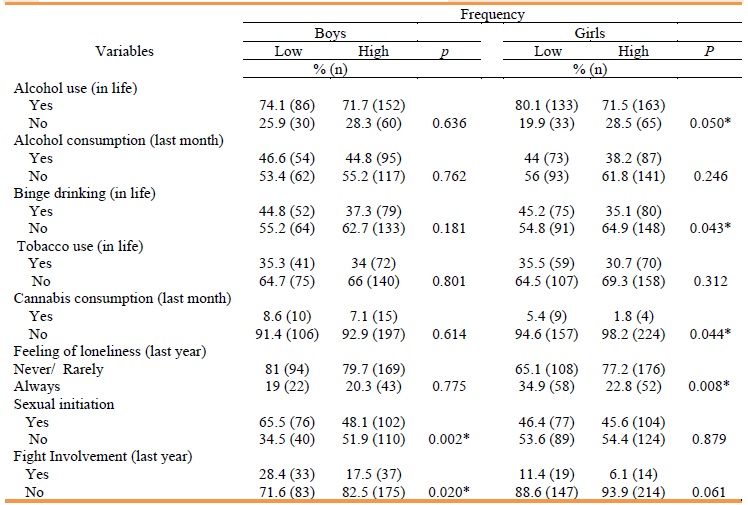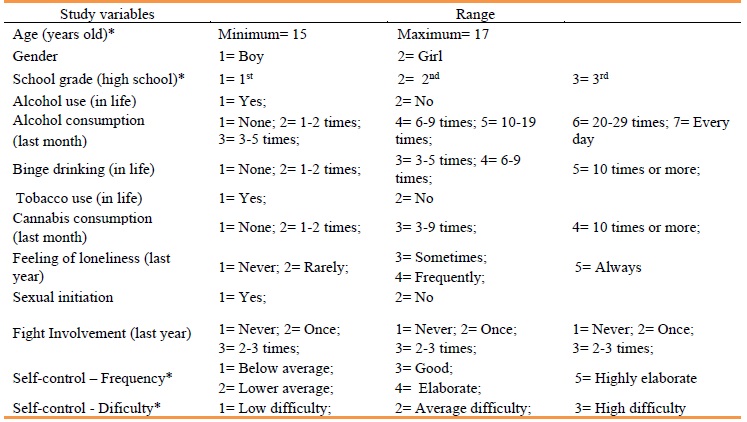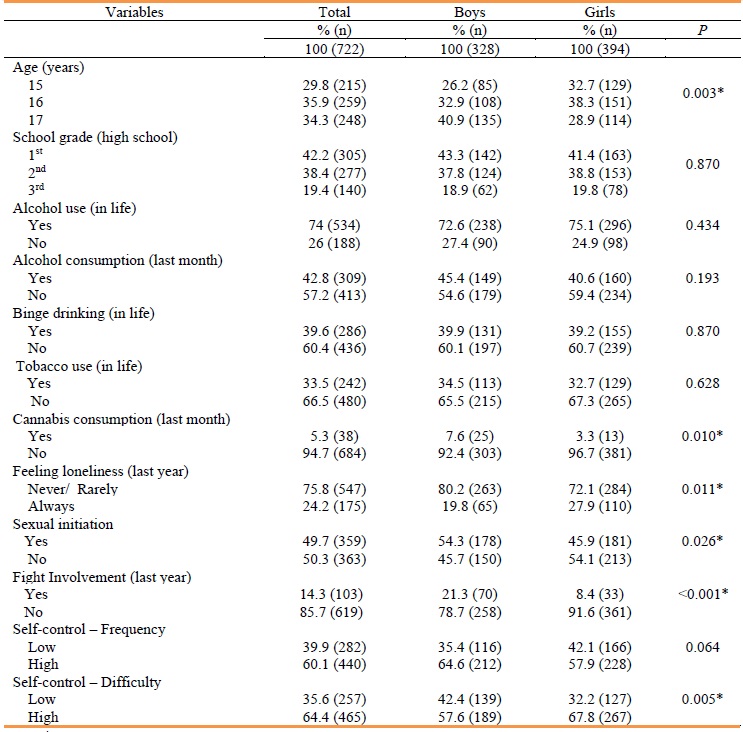Studies on consumption indicators show high prevalence and association with other risk factors in the adolescents health behaviours (Coutinho et al., 2016; Hallal et al., 2017; Horta et al., 2018). The relationship between substances use has been identified with other risk behaviours such as loneliness and fight involvement (Kim et al., 2018; Malta et al., 2018). Substance use in conjunction with risk behaviors such as exposure to violence in the border region in general has been characterized as a public health problem, and this region presents an atypical scenario with economic and social challenges increasing the possibility of involvement of adolescents in exploitation systems, increasing the risk to health vulnerability (Priotto, 2019).
Self-control is defined as an ability to demonstrate balance in situations that can cause discomfort, frustration, humiliation or anger (Del Prette & Del Prette, 2009). Despite the recognition that self-control has a positive influence on adolescent consumption indicators, the relationship with other risk factors is still an issue to be explored due to the variety of factors and possibilities of interventions (de Winter et al., 2016). Another important point to be considered in this relationship, would be the definition of priorities in conducting research and intervention studies, an issue that can be mitigated by the results of surveys on adolescent health on a national and international level (Brasil, 2016; Matos & Equipa Aventura Social, 2018; WHO, 2016).
However, the importance of identifying priorities at local and regional level for consumption indicators and other risk factors of interest for future interventions is highlighted (Dos Reis et al., 2018). Thus, the study's hypothesis was that the high frequency of consumption indicators and risk factors in adolescent behaviour would be associated with low self-control among adolescents. Therefore, the objective of this study is to analyze the associations between self-control, consumption indicators and risk factors in the behaviour of adolescents.
Methods
Cross-sectional study developed with adolescents from public schools in Foz do Iguaçu, Brazil. The region is bordered by Paraguay and Argentina and presents an atypical characterization in relation to the labor market, socio-economic, favoring the involvement and adolescents in the cycle of risky behaviors such as informal work, trafficking in goods and substances and prostitution (Aguiar, 2012). It was preceded by the consent of the institutions and participants as well as their legal guardians, respecting voluntary and anonymous participation. This research was approved by the research ethics committee of the Ribeirão Preto School of Nursing - University of São Paulo. This study was developed in accordance with the Declaration of Helsinki.
For data collection, an instrument validated by the National School Health Survey, authorized by the Brazilian Institute of Geography and Statistics (Brasil, 2016). A population-based survey was conducted with students from public schools in Brazil. This study is developed since 2009 and the instrument is structured with questions that include socio-demographic, risk and protective factors on adolescents’ health (Oliveira et al., 2017).
There was also used the Social Skills Inventory for Adolescents (Del Prette & Del Prette, 2009), which evaluates the social skills repertoire of adolescents, presented on a five-point Likert scale for frequency and difficulty. The values filled up by the respondents are converted into percentiles and later the scores for empathy, self-control, civility, assertiveness, affective approach, social resourcefulness and total are calculated as specified in the manual (Del Prette& Del Prette, 2009). In this study was used self-control indicator for frequency and difficulty, which has internal consistency index of .72 and .75 respectively.
Participants
The final sample considered from refusals and dropouts was 722 adolescents. The average age of the adolescents was 16.5 years (SD = 0.80), being distributed between 1st year (M = 15.6; SD = 0.78), 2nd year ( M = 16.1; SD = 0.63) and 3rd year (M = 16.9; SD = 0.33) of high school and technician from public schools in Foz do Iguaçu.
Measures and Variables
This study includes variables of socio-demographic characterization, alcohol use and consumption, binge drinking, tobacco use, cannabis use, feeling of loneliness, sexual initiation and fight involvement. Self-control was calculated using the frequency indicator, which initially presented 5 levels of classification and was subsequently recoded into 2 levels, High (Highly elaborated, Elaborated and Good) and Low (Lower medium, Below lower average). And the difficulty indicator that was recoded in Low and High (Medium / High difficulty). The measures are shown in Table 1.
Statistical data analysis
The statistical analysis was performed through the descriptive test for all variables. Chi-square test was used to analyze the relationship between the indicators of substance use, risk factors and self-control. Binomial Logistic Regression was used, using the “ENTER” method to analyze the influence of independent variables on self-control. The SPSS version 24 program was used for statistical analysis. The level of significance was p <0.05.
Results
In general, adolescents had a higher prevalence in the indicators of alcohol use, 74% (n = 534), alcohol consumption, 42.8% (n = 309), binge drinking, 39.6% (n = 286) and tobacco use, 33.5% (n = 242) compared to the national average (Brazil, 2016). The adolescents showed a high frequency, 70.4% (n = 508) and difficulty, 64.4% (n = 465) in self-control.
The boys showed higher alcohol consumption, 45.4% (n = 149), tobacco use, 34.5% (n = 113), cannabis use, 7.6% (n = 25), sexual initiation, 54 , 3% (n = 178) and fights involvement, 21.3% (n = 70) than girls. Girls reported greater use of alcohol, 75.1% (n = 296) and greater feeling of loneliness, 27.9% (n = 110) than boys. The binge drinking had a similar percentage for both genders, 39.9% (n = 131) for boys and 39.2% (n = 155) for girls. The values are shown in Table 2.
For boys, the decrease in the frequency of self-control was related to the increase in sexual initiation and fights involvement. For girls, the increase in alcohol use, binge drinking, cannabis consumption and the feeling of loneliness were related to the reduction in the frequency of self-control.
The increased difficulty in self-control for boys was related to fights involvement. The girls who presented an increase in the difficulty of self-control had a relationship with the increase binge drinking, tobacco use and feeling of loneliness. Alcohol consumption was correlated with the increased difficulty in self-control for both genders. The results are shown in Tables 3 and 4.
Table 3 Bivariate analyzes of frequency in self-control, consumption indicators and risk factors in Brazilian adolescents, by gender, with chi-square. Foz do Iguaçu, Brazil, 2021.

The results of the Binomial Logistic Regression analysis for the association between self-control, consumption indicators and risk factors in adolescents in border region were analyzed using two adjusted models, in which the regression explained 4% of the frequency variance (Hosmer and Lemeshow χ2 = 20.806 (10), p = 0.022 Nagelkerke R 2 = 0.039) and 7% of the difficulty (χ2 = 40.895 (10), p <0.001 Nagelkerke R 2 = 0.075) of self-control for the model indicators. The condition of having a decrease in the frequency of self-control has a negative relationship with the variable fights involvement (fights involvement increases the chance of being in this group by 0.57 times).
The model also presents an increased difficulty in self-control with a positive relationship with the variable alcohol consumption (consuming alcohol increases the chance of being in this group by 0.60 times) and the feeling of loneliness (the increase in the feeling of loneliness increases the chance of being in this group by 0.56 times. The results are shown in Table 5.
Table 4 Bivariate analyzes of the difficulty in self-control, consumption indicators and risk factors in Brazilian adolescents, by gender, with chi-square. Foz do Iguaçu, Brazil, 2021.

Discussion
The objective of this research was to analyze the association between self-control, consumption indicators and risk factors in adolescent’s behaviour. The results obtained suggest that fight involvement, alcohol consumption and feeling of loneliness are associated with adolescent’s self-control. These results are confirmed by a previous study related to the influence of emotional self-control on loneliness and substance use (Nikmanesh et al., 2015).
The greater vulnerability of boys in the consumption indicators and other risk factors in the adolescent’s behaviour pointed out in this study, was a trend in population studies (Malta et al., 2018) demonstrating the increase in alcohol consumption among girls in recent years (Freitas et al., 2019) in border region (Priotto, 2019). These data are important for researchers and managers when planning future interventions.
The relationship between the frequency of self-control and risk factors in adolescents behaviour was also identified in the results of a long-term survey, that showed that the decrease in self-control in adolescence influences the maintenance of risk behaviours for sexuality in adulthood (Griffin et al., 2012). In the same direction, the variety of risk factors associated with reduced self-control identified in this study, represent the importance and complexity of setting priorities for interventions involving adolescent health prevention (Davies et al., 2017; Walters et al., 2018). Similar results were presented by studies that demonstrated low levels of self-control in adolescents in relation to multiple risk factors (de Winter et al., 2016), alcohol use (Bobrowski, 2019; Wills et al., 2016), binge drinking (Ismayilova & Terlikbayeva, 2018), victimization by violence (Davis et al., 2017), tobacco use (Fauzan et al., 2018; Holmes, 2018) and alcohol use associated with premature sexual activity in adolescents (Agbaria et al, 2017).
In addition, this evidence highlights the importance of the fights involvement, alcohol consumption and feeling of loneliness in planning research and interventions with adolescents in border region, giving importance to learning self-control strategies related to substance use behaviours and other risk factors in adolescents. Therefore, from the point of view of health education in relation to health prevention and promotion, family, school and peer relationships are important and should be better explored as regulators of isolation reactions and other risk behaviours (De la Fuente et al., 2017). These results point out the importance of programs aimed at preventing consumption indicators, based on the training of self-control to manage behaviours of fight involvement, alcohol consumption and isolation.
The study presents a complex and rigorous sampling process, making it possible to generalize the results to the population, being useful for the use of health behavior monitoring. However, some limitations can be clarified, the study was self-reported and presents a cross-sectional design methodology, and it is not possible to establish a cause-effect relationship. The study also addressed the relationship between self-control and the survey indicators, thus not demonstrating the relationship between the other classes of social skills as well as the general repertoire.
The results of this study identified the association of self-control with consumption indicators and risk factors in adolescent’s behaviour, mainly identifying self-control as a protective factor for the fight involvement, alcohol consumption and feeling of loneliness. This risk behaviours evaluated in the research reveal a priority for intervention in Brazilian adolescents for the development of future studies in border region. Thus, it is essential to plan research and interventions based on the promotion of self-control, in addition to carrying out interventions in conjunction with school, family and peers in order to reduce consumption indicators and other risk factors in adolescence.
The results call attention to the importance of studies of this nature for the design of more effective intervention programs and policies, in addition to the prioritization of results identified in population surveys to improve coping strategies in education and health. Finally, this study confirms the impact of consumption indicators and risk behaviours in adolescent’s behavior and the importance of self-control as a strategy for the development of education and public health programs and policies.
Key points
Self-control in adolescents is associated with fight involvement, alcohol consumption and feeling of loneliness.
The factors alcohol use, binge drinking and cannabis consumption, feeling of loneliness and fight involvement are related to the low frequency of self-control for girls.
For boys, sexual initiation and fight involvement were related to the frequency of self-control.
Feeling of loneliness, alcohol consumption, binge drinking and cannabis consumption were related to increased difficulty in self-control for girls.
For boys, the increased difficulty in self-control was related to the alcohol consumption, feeling of loneliness and fight involvement.


















